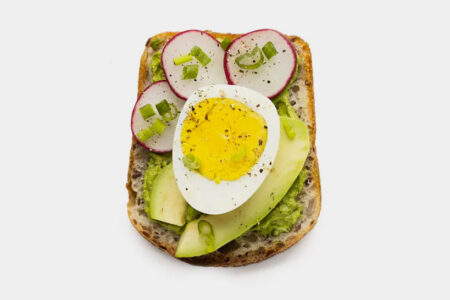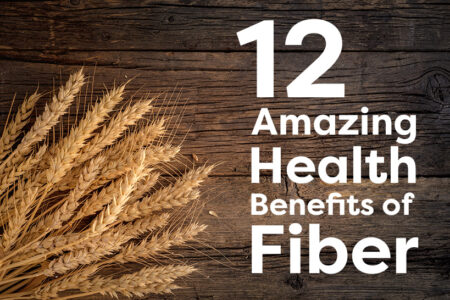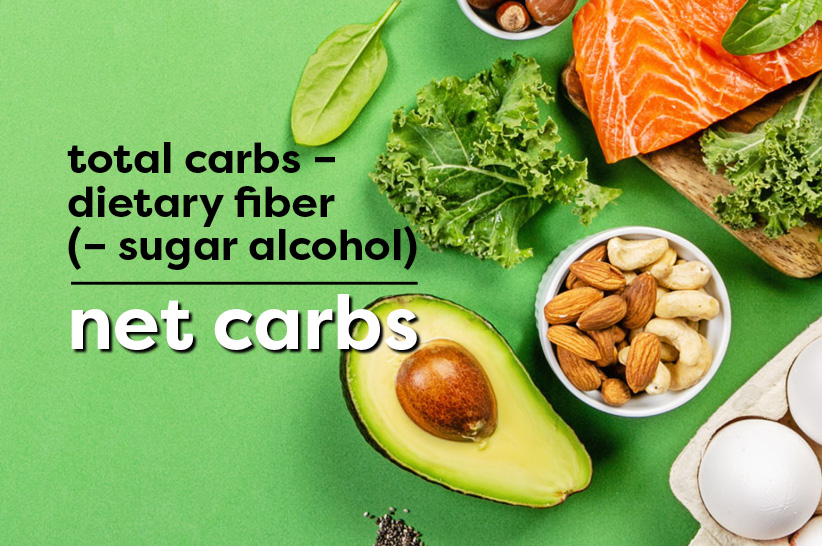What are net carbs? This is a question that a lot of people on a low-carb diet ask. Find out more in this article.
The term “net carbs” is often seen in food product labels, and it can make you stop and wonder what it actually means. Shouldn’t carbs just be called carbs? Net carbohydrates is an important concept if you’re following a diet, such as keto, that limits your carb intake.
It may not be officially recognized by nutritionists or unregulated by the FDA, but knowing it will enable you to make better food choices on a low-carb diet. Learn more below.
What Are Net Carbs?
Your net carb value on keto refers to the number of carbohydrates in food minus the fiber and sugar alcohol it contains. Total carbs, on the other hand, include all fiber and sugar alcohols.
As your body digests carbohydrates, most of the carbs get converted into glucose. The rest of them are non-digestible, such as dietary fiber and sugar alcohol 1, 2.
Note that there are two main types of carbs, namely “simple carbs” and “complex carbs”. Simple carbs are easily digested while complex carbs take a while. They often contain fiber.
When it comes to fiber, study tells us that fiber remains intact in plants. Examples include fruits, vegetables, and grains. Furthermore, fiber helps you feel full and aids in a healthy digestion 1.
Meanwhile, certain sugar alcohols are poorly digested and cause loose stools if consumed in excess amounts 2. Examples of sugar alcohols include erythritol, xylitol, maltitol, sorbitol, and isomalt.
Fun fact: Sugar alcohols are tooth-friendly and do not contribute to dental caries.
Net Carbs vs Total Carbs
On a low-carb diet, carbohydrates make up only 5% to 10% of your total daily calorie intake. So if you’re on a 2,000 calorie per day diet, you should limit carbs to about 20-50 grams a day 3.
This tells us that keeping track of carbs or net carbs on keto matters more than we think. Going above your total carb limit will raise your blood sugar levels and insulin levels, kicking you out of ketosis.
Total carbohydrates are exactly what you think — they account for all the carbs in the food you eat. As mentioned previously, this includes fiber and sugar alcohol. You’ll be able to see the value for the fiber and sugar alcohol (if present) on a food label. Net carbs are the remaining carbs that convert into glucose after you’ve taken away the fiber and sugar alcohol.
In the keto community, there’s a debate on whether net carbs matter or if one should rather focus on total carbohydrate count.
The answer to this question will actually depend on a couple of factors. For instance, if you’re following the keto diet for medical reasons and if it’s prescribed by your doctor, it might be best to count total carbs to avoid the risk of exceeding your limit.
Some people, on the other hand, feel their best by calculating net carbs while being able to remain in ketosis. But if sticking to net carbs fails to put your body in a fat-burning state, it may be ideal to stick to total carbs instead.
But don’t just obsess net carbs vs total carbs. More importantly, pay attention to the quality of carbs you’re consuming. We wrote an article where you’ll learn the difference between good carbs and bad carbs and provided specific food examples.
How To Calculate Net Carbs
Now that we’ve discussed the difference between carbs and net carbs, the next thing to know is how to calculate net carbs. To do that, follow this simple formula:
Net carbs = Total carbohydrate – Fiber – Sugar alcohol
Let’s take an example. Say, a piece of keto-friendly chocolate bar has 20 grams of TOTAL CARBS, 10 grams of DIETARY FIBER, and 7 grams of SUGAR ALCOHOL (erythritol).
Your net carb calculation would be:
3 grams net carbs = 20 grams total carbs – 10 grams fiber – 7 grams sugar alcohol (erythritol)
Whole foods
Keto-friendly whole foods such as leafy greens, cruciferous vegetables, and low-carb fruits contain fiber.
Since these foods do not come with nutrition facts labels at the grocery, you can simply rely on a nutrition database like FoodData Central. When you enter any food, it gives you full information on the specific amount of carbs, protein, fiber, minerals, water, and more.
Using FoodData Central, I’ve entered raw avocado (1 cup, cubes) and retrieved the following information which helps me get its net carbs:
- Total carbohydrate: 12.8 g
- Dietary fiber: 10 g
After I subtract dietary fiber of 10 grams from 12 grams, I would get 2.8 grams of net carbs. Take note that whole foods are devoid of sugar alcohols, so you won’t take that into account.
Processed foods
Foods that undergo processing such as bars, cookies, and other forms of keto snacks, may contain certain sugar alcohols aside from fiber. This is especially true in sweet keto foods.
Sugar alcohols taste sweet, but they’re unlike regular sugars in that they’re not fully digested. So, they don’t cause blood sugar spikes. Another thing to know is that your gut bacteria ferments sugar alcohols, causing gas and bloating. This explains why some people cannot tolerate them.
You need to subtract half the grams of a sugar alcohol (that’s on the label) from the food’s total carbs. For example, if a nutrition facts label has 6 grams of the sugar alcohol maltitol, you’re going to subtract half of the amount (3 grams) from the total carbs listed.
The exception would be erythritol. For erythritol, you need to subtract its full amount in grams from the total carbs. So, for instance, if a keto bar has 5 grams of erythritol, you subtract 5 grams from the total carbs to get the net carbs. Erythritol has no impact on glucose and insulin levels at all, making it a safe option for people with diabetes.
Should You Always Be Calculating Net Carbs?
Tracking net carbs has its share of advantages and disadvantages.
One advantage of calculating net carbs include the freedom and flexibility to explore more food options. Sticking to total carbs will somehow limit your number of choices.
And since your total carb intake is higher, because you’re only counting net carbs, this may benefit your workouts — especially if you’re doing high-intensity exercises that deplete glycogen fast. You’ll need that extra energy to get the most out of your sweat session.
Being able to eat more fiber in your diet is another benefit of counting net carbs. A lot of high-fiber foods contain a higher amount of total carbs. Examples include cashew nuts and baby carrots.
For those who are just getting started with the keto diet, net carbs will prevent their energy from dropping too low as well as hypoglycemia.
A big downside is the tendency to overeat snacks and treats. Over time, this may lead to a keto weight loss stall. You may have lost pounds when you first started, but there will come a time when you no longer see the number on the scale move.
Some people also do best with tracking a food’s total carbs instead of net carbs. They find that they lose fat faster and that they’re able to monitor their carb intake for the day more accurately.
Just keep in mind that to lose weight via ketosis, stick to a daily carb limit of 50 grams of net carbs or less.
Summary
We’ve already answered the question, “What does net carbs mean?” Again, you calculate net carbs by subtracting fiber and sugar alcohol from the total carbs. With that, it’s important to know their specific amounts in the foods you eat. Check the food labels or use a food and nutrition database online for whole foods.
Should you keep net carbs or total carbs? Well, that varies per individual. Whether you focus on your net carb count or not depends on your individual response to carbs. It helps to consider your weight loss goals, the possibility of stalling, your workouts, and the advice of your doctor if you have a medical condition.










![Juicing for Weight Loss: Everything You Need to Know [Plus Recipes]](/wp-content/uploads/2019/08/Juicing-for-Weight-featured-image.jpg)








